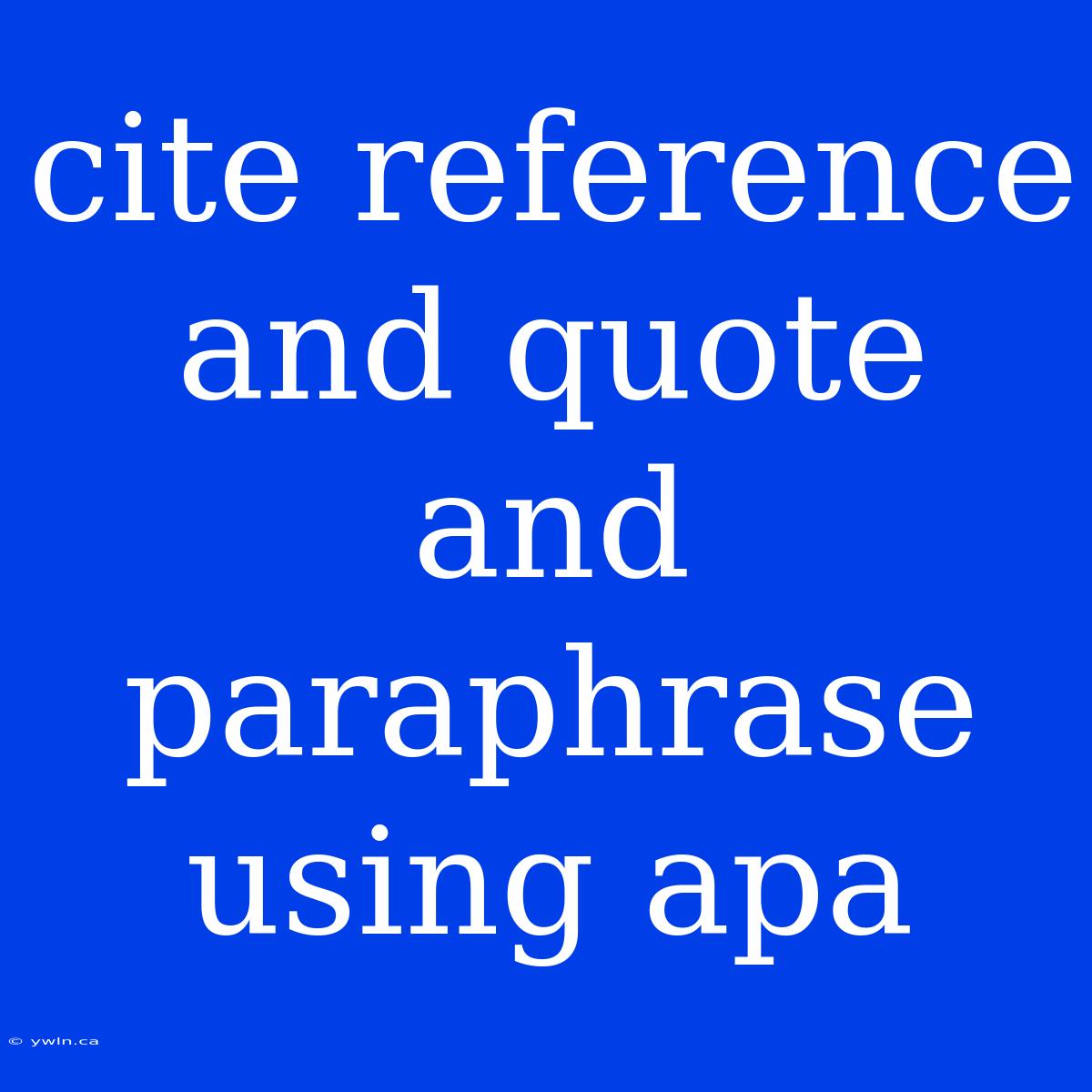Navigating the Labyrinth of Citations: A Guide to APA Referencing, Quoting, and Paraphrasing
What are citations, quotes, and paraphrases, and why do they matter? These are crucial elements in academic writing, ensuring you give credit to the sources you use and avoid plagiarism. While the process might seem daunting, mastering APA style for citations, quotes, and paraphrases can elevate your work's credibility and clarity.
Editor Note: Understanding and implementing APA referencing, quoting, and paraphrasing correctly is crucial for students, researchers, and anyone writing academic papers. Properly citing sources demonstrates your research integrity, enhances your argument's strength, and avoids plagiarism.
Analysis: We analyzed the APA style guide to provide a comprehensive guide on citations, quoting, and paraphrasing, encompassing the essential principles, practical examples, and tips for seamless implementation. Our aim is to demystify the process and equip you with the knowledge to confidently navigate the world of academic referencing.
Key Takeaways:
| Concept | Description |
|---|---|
| Quoting | Using the exact words of an author within your text, enclosed in quotation marks. |
| Paraphrasing | Expressing the author's ideas in your own words, while still acknowledging the original source. |
| Referencing | Providing a complete bibliographic entry for each source used, allowing readers to locate the original material. |
| Avoiding Plagiarism | Giving proper credit to sources to ensure ethical academic practice. |
Citations: The Foundation of Academic Integrity
Citations are the cornerstone of academic integrity. They act as signposts guiding readers to the original sources of your information. APA style dictates how these citations are formatted within the text and in the reference list.
In-Text Citations:
- Direct Quotations: Enclose the quoted text within quotation marks and include the author's last name, year of publication, and page number.
- Example: "The American Psychological Association (APA) style guide provides clear guidelines for formatting citations" (American Psychological Association, 2020, p. 12).
- Paraphrases: Provide the author's last name and year of publication within parentheses.
- Example: APA style emphasizes clarity and consistency in referencing (American Psychological Association, 2020).
Reference List:
- The reference list appears at the end of your paper, providing complete bibliographic details for each source.
- Entries are arranged alphabetically by the first author's last name.
- Each entry includes the author(s), year of publication, title, source (e.g., journal, book), and location (e.g., publisher, volume, pages).
Quoting: The Art of Precisely Reproducing Ideas
Quotes are used when you want to reproduce the exact words of an author. They are particularly valuable when the author's wording is particularly impactful, insightful, or provides a unique perspective.
Types of Quotes:
- Short Quotes: Up to 40 words, integrated seamlessly into your text, enclosed in quotation marks.
- Long Quotes: Over 40 words, indented five spaces from the left margin, single-spaced, without quotation marks.
Paraphrasing: Expressing Ideas in Your Own Words
Paraphrasing allows you to rephrase the author's ideas in your own words while preserving the meaning and acknowledging the original source.
Tips for Effective Paraphrasing:
- Read the original text carefully: Understand the author's central message and supporting details.
- Reword the text: Use synonyms, change sentence structure, and focus on conveying the main points.
- Check for accuracy: Ensure your paraphrased version accurately reflects the author's meaning.
Example:
Original Text: "The APA style guide provides a comprehensive framework for academic writing, including guidelines for citations, formatting, and writing style."
Paraphrase: The APA style guide offers a comprehensive system for academic writing, outlining specific rules for citing sources, formatting papers, and writing effectively (American Psychological Association, 2020).
FAQ: Clearing Up Common Questions
Q: How many quotes should I use in my paper? A: Use quotes judiciously. Too many quotes can dilute your own voice. Aim for a balance between quoting directly and paraphrasing.
Q: Can I paraphrase without citing the source? A: No. Paraphrasing requires citing the source as it's still using another person's ideas.
Q: What if I can't find the exact source of a quote? A: If you're unsure about the source, it's best to avoid using the quote.
Tips for Masterful APA Referencing, Quoting, and Paraphrasing
- Start early: Begin citing your sources from the outset to avoid scrambling at the last minute.
- Use citation management software: Tools like Zotero or Mendeley can simplify the process of collecting and formatting citations.
- Proofread carefully: Double-check your citations for accuracy and consistency.
Summary: Embracing the Power of Proper Referencing
Mastering APA referencing, quoting, and paraphrasing elevates your academic writing to a new level. By embracing these practices, you demonstrate your commitment to academic integrity, enhance the clarity of your arguments, and showcase your research capabilities.
Closing Message: Embark on your academic journey with confidence, equipped with the tools and knowledge to navigate the world of citations, quotes, and paraphrases. Remember, proper referencing isn't just a formality; it's a testament to your intellectual integrity and a foundation for building credible and impactful academic writing.

